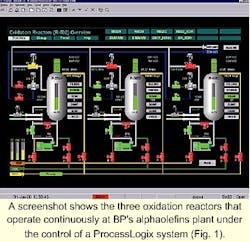A new distributed-control system (DCS) at BP's Pasadena, Tex., alphaolefins plant allows it to operate at 105% of its theoretical maximum.
When BP, then BP Amoco, purchased the plant in 1998, it was using the same pneumatic controls and relays that had been installed when the plant was built 30 years before.
With the help of Control Dynamics Inc. (CDI), a systems integrator in Houston, BP Amoco installed a Rockwell Automation ProcessLogix control system at the front end of the alphaolefins process.
Old system
Before BP Amoco installed the ProcessLogix system, it did not realize how difficult the plant was to operate. "We didn't know we had so many things broken," said Martin Fonteno, I&E (instrumentation and electrical) specialist at BP. "We had valves that didn't stroke all the way, relays that were failing, and relays that had been jumpered around years ago."
The main problem was that the old control system had no feedback and no HMI (human-machine interface) monitoring system. Because annunciator panels did not always work, operators were not notified when problems arose.
With the pneumatic system, even charging a reactor was an adventure. The operator would open the necessary valves from the control room, and then go out into the plant with a hammer or a crowbar. After checking to see if all the valve indicators were in the proper position, the operator used the crowbar to open sticky valves all the way and check levels in the reactor vessels with a sight glass.
A chart on the wall of the control room listed optimum values for charge time, oxidation times, and fill rates, but the operators had no way of monitoring events. "On our best days, we operated at about 75% of capacity," says Fonteno, "with a rework rate of about 30%."
Sometimes, the bad batch could be reused, but in many cases, the reactor vessel had to be shut down. Fonteno estimates that it cost $100,000 for each day a reactor was down while maintenance people tried to diagnose the problem.
New system
The ProcessLogix system controls the activities of three batch reactors, all of which make the same product. The process involves filling the reactor vessel with titanium tetrachloride and ethylene, then oxidizing the mixture with air that is blown in from the bottom during agitation.
The system must very carefully control the air flow because the mixture should build heat but not catch fire. Fig. 1 shows the new computer screenshot using the DCS.
All the reactors are running at top speed under the new control system.
"We are running this process as fast as possible for the first time in its life," said Fonteno. "In fact, we are actually operating at 105% of the theoretical maximum production rate."
Today, the rework rate is zero because the new system has never made a bad batch. Also, it detects problems that can be solved with preventive maintenance. For example, the software can detect when an agitator motor is running hot, when a flow switch is chattering, or a valve is sticking.
BP has been running the new control system for about 11 months and is ready to expand the system by installing ProcessLogix systems in other parts of the plant. Immediate projects include a tank farm and several towers that are running under manual control.



